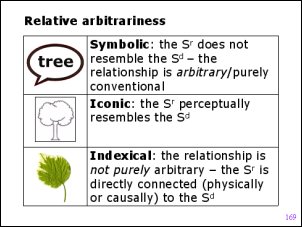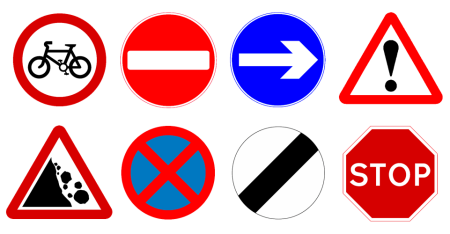Differentiate, illustrate and critically discuss the use and significance of symbolic, iconic and indexical relations in British road signs.
For general guidance about what is expected in your essays for this module,
see the
general criteria.
Please remember to avoid footnotes and to include an
alphabetical list of 'References' which have been cited in the text
(not a Bibliography of anything you have read for the essay). This list should include
author's names, date, book titles (in italics), place of publication and publisher.
Within the text always cite author's surname, date and page number. Double-space your
text and number your pages. For more detailed notes on writing essays in this
department, click
here.

Advice for this particular assignment:
The most relevant lectures for this topic are
Lecture 2: Relative Arbitrariness and
Lecture 4: Codes.
A useful and official online source of British road signs is
here.
Demonstrate your understanding of the most relevant semiotic issues and concepts, including the symbolic, iconic and indexical modes
and relative arbitrariness. However, avoid 'explaining' these terms since the reader obviously knows what they mean!
Make it clear (briefly: one sentence is enough) that you are aware that these concepts come from Peirce, even though
you are following the common practice of using the Saussurean terms 'signifier' (to refer to the physical
form of the sign) and 'signified' (to refer to the concept or referent for which it stands).
Do not slip into referring to symbols, icons and indexes as 'types' of signs
(rather than as relations between the signifier/sign and the signified/referent): an image, for instance, can be simultaneously
symbolic, iconic and/or indexical, although one mode tends to be dominant. However, the road signs themselves can be
divided into groups reflecting the relative dominance of particular semiotic modes, so show what you think these groups
might be.
Note that on one level, all public signage is
conventional (and thus semiotically symbolic) as part of a system of signs (a code), and that insofar as a sign is only relevant
by virtue of its location it is also to that extent indexical. Remember also that just because an image resembles
something that you recognise does not necessarily make it iconic - the resemblance may not relate directly to what the sign
is intended to signify.
Work within the conceptual framework (and key terms) provided by
the lecture slides and the book, Semiotics: The Basics. If you adopt concepts and frameworks from other sources
you may get confused (especially since some sources actually get key details wrong!).
As long as you stay within this framework you are of course expected to show that you have
also consulted other relevant sources.
Note also that this is an assignment for which the inclusion of relevant pictorial illustrations is expected.
Remember to include a list labelled either Figures or Image sources after your
list of References.
Some suggested reading
- Abdullah, Rayan & Roger Hübner (2007)
Pictograms, Icons & Signs: A Guide to Information Graphics. London: Thames & Hudson.
- Baines, Phil & Catherine Dixon (2008)
Signs: Lettering in the Environment. London: Laurence King
- Barnard, Malcolm (2005)
Graphic Design as Communication. London: Routledge
- Berger, Arthur Asa (1989)
Seeing is Believing: An Introduction to Visual Communication. Mountain View, CA: Mayfield
- Bergström, Bo (2008)
Essentials of Visual Communication. London: Laurence King
- Castro, Cándida & Tim Horberry (Eds) (2004)
The Human Factors of Transport Signs. Boca Raton, FL: CRC Press
- Chandler, Daniel (1998)
Semiotics for Beginners. [WWW document] URL
http://users.aber.ac.uk/dgc/media/Documents/S4B/semiotic.html
- Chandler, Daniel (2007)
Semiotics: The Basics (2nd Edn.). London: Routledge
- Chandler, Daniel and Rod Munday (2011)
Dictionary of Media and Communication. Oxford: Oxford University Press
- Cohen, Tamarah & Kerstan Bond Cohen (nd)
'Re-de-signing "People"' Kyoto Journal: Unbound - Gender in Asia Online
[WWW document] URL
http://www.kyotojournal.org/gender/redesigning_people.shtml
- Cook, Guy (1999)
The Discourse of Advertising (2nd Edn.). London: Routledge
- Crow, David (2003)
Visible Signs: An Introduction to Semiotics. Crans-près-Céligny, Switzerland: AVA
- Danesi, Marcel (1994)
Messages and Meanings: An Introduction to
Semiotics. Toronto: Canadian Scholars' Press [caution - labels photographic media as primarily iconic rather than primarily indexical]
- Danesi, Marcel (2002)
Understanding Media Semiotics. London: Arnold [caution - labels photographic media as primarily iconic rather than primarily indexical]
- Department of Transport (2007)
Know Your Traffic Signs. London: HMSO
- Eaton, Marcia (1980) 'Truth in Pictures', Journal of Aesthetics and Art Criticism 39(1): 15-26
- Emmison, Michael & Philip Smith (2002)
Researching the Visual: Images, Objects, Contexts and Interactions in Social and Cultural Inquiry
(Introducing Qualitative Methods). London: Sage
- Evamy, Michael (2003)
World Without Words. London: Laurence King
- Fiske, John (1990)
Introduction to Communication Studies. London: Routledge
- Frutiger, Adrian (1989)
Signs and Symbols: Their Design and Meaning (trans. Andrew Bluhm): London: Studio Editions
- Gombrich, Ernst H. (1972)
'The Visual Image: Its Place in Communication', Scientific American 272: 82-96; also in
Ernst Gombrich (1982)
The Image and the Eye. Oxford: Phaidon, pp. 137-61 &
Ernst Gombrich (1996)
The Essential Gombrich. Oxford: Phaidon, pp. 41-64
- Jamieson, Harry (2012)
Visual Communication. Bristol: Intellect
- Johansson, Troels Degn, Martin Skov & Berit Brogaard (Eds.) (1999)
Iconicity: A Fundamental Problem in Semiotics. Århus: NSU Press.
- Kjørup, Søren (1974)
'George Inness and the Battle at Hastings, or Doing Things with Pictures', The Monist 58(2): 216-35
- Korsmeyer, Carolyn (1985)
'Pictorial Assertion', Journal of Aesthetics and Art Criticism 43(3): 257-65
- Krampen, Martin (1983)
'Icons of the Road', Semiotica 43(1/2): 1-204
- Kress, Gunther & Theo van Leeuwen (1996)
Reading Images: The Grammar of Visual Design. London: Routledge
- Lester, Paul Martin (2005)
Visual Communication (4th edn). Belmont, CA: Wadsworth
- Miller, Jonathan (1983)
States of Mind. London: Phaidon (‘Dialogue with Ernst Gombrich', pp. 212-31).
- Mustienes, Carlos & Thomas Hilland (Eds) (2004)
1000 Signs (Colors Magazine). Köln: Taschen
- Novitz, David (1977)
Pictures and Their Use in Communication. The Hague: Martinus Nijhoff
- Sassoon, Rosemary & Albertine Gaur (1997)
Signs, Symbols and Icons: Pre-History to the Computer Age. Exeter: Intellect
- Smith, Ken et al. (Eds) (2005)
Handbook of Visual Communication. Mahwah, NJ: Erlbaum
- Sonesson, Göran (1988)
Pictorial Concepts: Inquiries into the Semiotic Heritage and its Relevance for the Analysis of the Visual World.
Lund: Lund University Press
- Studnicki, F. (1970)
'Traffic signs', Semiotica 2(2): 151-72
- Uebele, Andreas (2009)
Signage Systems & Information Graphics: A Professional Sourcebook. London: Thames & Hudson
- van Leeuwen, Theo & Carey Jewitt (Eds.) (2001)
Handbook of Visual Analysis. London: Sage
- Worth, Sol (1981)
'Pictures Can't Say Ain't'. In Sol Worth (1981)
Studying Visual Communication) [WWW document] URL
http://www.academia.edu/2846340/Studying_visual_communication
;
RESTRICTED
Note: Treat with extreme caution sources labelled with this symbol!





